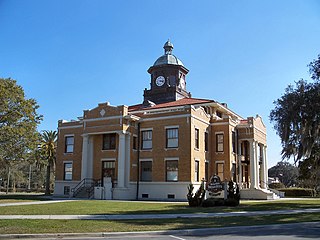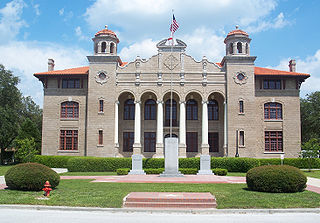
Richardsonian Romanesque is a style of Romanesque Revival architecture named after architect Henry Hobson Richardson (1838–1886). The revival style incorporates 11th and 12th century southern French, Spanish and Italian Romanesque characteristics. Richardson first used elements of the style in his Richardson Olmsted Complex in Buffalo, New York, designed in 1870. Multiple architects followed in this style in the late 1800s; Richardsonian Romanesque later influenced modern styles of architecture as well.
Robert Mills, a South Carolina architect known for designing both the first Washington Monument, located in Baltimore, Maryland, as well as the better known monument to the first president in the nation's capital, Washington, DC. He is sometimes said to be the first native-born American to be professionally trained as an architect. Charles Bulfinch of Boston perhaps has a clearer claim to this honor.

Georgia College & State University is a public liberal arts university in Milledgeville, Georgia. The university enrolls approximately 7,000 students and is a member of the University System of Georgia and the Council of Public Liberal Arts Colleges. Georgia College was designated Georgia's "Public Liberal Arts University" in 1996 by the Georgia Board of Regents.
Frederic Joseph DeLongchamps was an American architect. He was one of Nevada's most prolific architects, yet is notable for entering the architectural profession with no extensive formal training. He has also been known as Frederick J. DeLongchamps, and was described by the latter name in an extensive review of the historic importance of his works which led to many of them being listed on the U.S. National Register of Historic Places in the 1980s.

The Allegheny County Courthouse in downtown Pittsburgh, Pennsylvania, is part of a complex designed by H. H. Richardson. The buildings are considered among the finest examples of the Romanesque Revival style for which Richardson is well known.

The Old Citrus County Courthouse is a historic site in Inverness, Florida located at 1 Courthouse Square. On April 17, 1992 it was added to the U.S. National Register of Historic Places. The building was designed by J. R. MacEachron and Willis R. Biggers.

Frederick John Osterling was an American architect, practicing in Pittsburgh from 1888.
William Augustus Edwards, also known as William A. Edwards was an Atlanta-based American architect renowned for the educational buildings, courthouses and other public and private buildings that he designed in Florida, Georgia and his native South Carolina. More than 25 of his works have been listed on the National Register of Historic Places.

The Hernando County Courthouse, built in 1913, is an historic courthouse building located in Brooksville, Florida, It was designed by Atlanta-based architect William Augustus Edwards who designed one other courthouse in Florida, two in Georgia and nine in South Carolina as well as academic buildings at 12 institutions in Florida, Georgia and South Carolina. He designed most of the original buildings on the campus of the University of Florida in Gainesville.

The Sumter County Courthouse, built in 1912–1914, is an historic courthouse building located in Bushnell, Florida. The total costs of construction for the courthouse were $56,000. It was designed by Atlanta-based architect William Augustus Edwards who designed one other courthouse in Florida, two in Georgia and nine in South Carolina as well as academic buildings at 12 institutions in Florida, Georgia and South Carolina. He designed most of the original buildings on the campus of the University of Florida in Gainesville. In 1989, The Sumter County Courthouse was listed in A Guide to Florida's Historic Architecture, published by the University of Florida Press.
Edward Columbus Hosford, also known as Edward C. Hosford and E. C. Hosford, was a Georgia-born American architect noted for the courthouses and other buildings that he designed in Florida, Georgia and Texas.

The Duval County Courthouse is the local courthouse for Duval County, Florida. It houses courtrooms and judges from the Duval County and Fourth Judicial Circuit Courts. The new facility is located Downtown Jacksonville, Florida; it was built starting in 2009 and opened in 2012.

Frank Pierce Milburn was a prolific American architect of the late 19th and early 20th centuries. His practice was primarily focused on public buildings, particularly courthouses and legislative buildings, although he also designed railroad stations, commercial buildings, schools and residences. Milburn was a native of Bowling Green, Kentucky who practiced as an architect in Louisville from 1884 to 1889; Kenova, West Virginia 1890-1895; Charlotte, North Carolina; Columbia, South Carolina; and Washington, D.C. after 1904. From 1902 Milburn was architect for the Southern Railway.

Joseph Warren Yost (1847–1923) was a prominent architect from Ohio whose works included many courthouses and other public buildings. Some of his most productive years were spent as a member of the Yost and Packard partnership with Frank Packard. Later in his career he joined Albert D'Oench at the New York City based firm D'Oench & Yost. A number of his works are listed for their architecture in the U.S. National Register of Historic Places (NRHP).

Willis R. Biggers was an architect in Florida during the early 20th century. He designed the Citrus County Courthouse with J. R. MacEachron and the original Plant City High School, which is now a community center. The old Sarasota High School building (1912) was also designed by Biggers, though the school moved to a new building on the South Tamiami Trail in 1926. The old building was used as a library until the Chidsey Library was built in 1940 and was used as a youth center and as a Works Progress Administration sewing room during World War II. It was demolished in the late 1950s.

The Ben Hill County Jail is a historic building in Fitzgerald, Georgia, located on Pine Street. It was built in 1909 in the Romanesque style, the first jail in the 1906-created county. It was designed by J. Reginald MacEachron, selected by a design competition in which 14 architects submitted proposals for the county's courthouse and jail. It is two stories high on a raised basement. It originally had an elaborately corbeled battlemented tower, but it was shortened between 1920 and 1935. The south entrance leads to the sheriff's living quarters which was used by the sheriff and his family until the 1950s. It was used until not too long before 1982.

The architecture of Jacksonville is a combination of historic and modern styles reflecting the city's early position as a regional center of business. According to the National Trust for Historic Preservation, there are more buildings built before 1967 in Jacksonville than any other city in Florida, but it is also important to note that few structures in the city center predate the Great Fire of 1901. Numerous buildings in the city have held state height records, dating as far back as 1902, and last holding a record in 1981.

The Madison County Courthouse in Danielsville, Georgia is a historic courthouse built in 1901. It was listed on the National Register of Historic Places in 1980.

The Clayton County Courthouse in Jonesboro, Georgia is a historic courthouse.
















